Warning: pic heavy, as usual. 
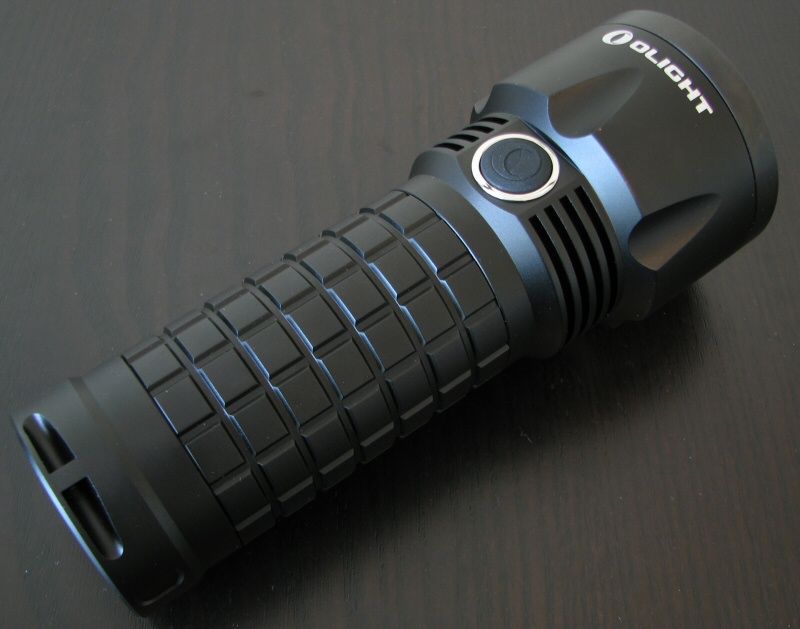
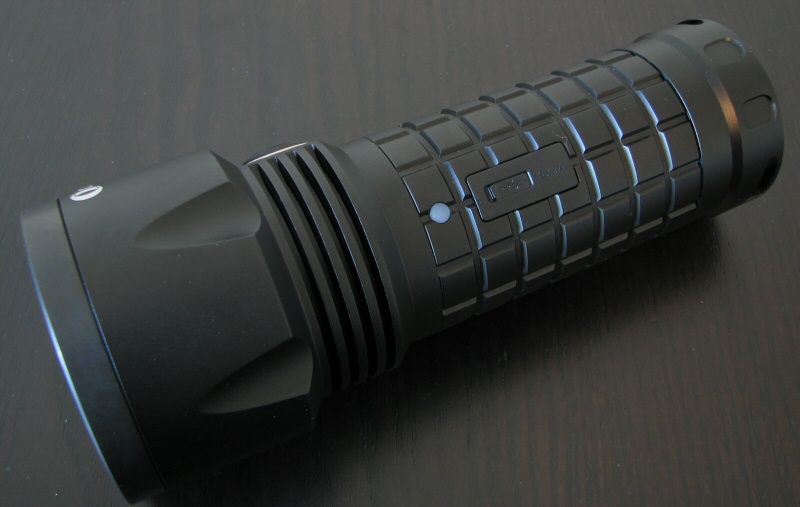
The SR52 is an updated version of the portable SR-series thrower model from Olight – now supporting 3x18650 as well as 6xCR123A. There have been some pronounced design changes from the earlier model SR51. There are also quite a few differences from the concurrent 3x18650 SR Mini flood-style light as well.
Let's see how it compares to everything …
Manufacturer Reported Specifications:
(note: as always, these are simply what the manufacturer provides – scroll down to see my actual testing results).
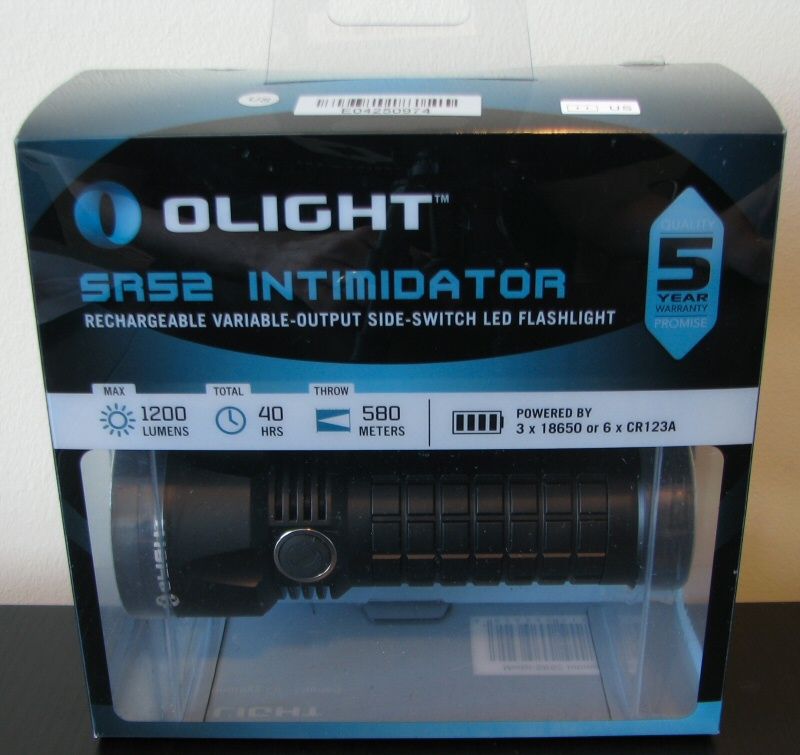
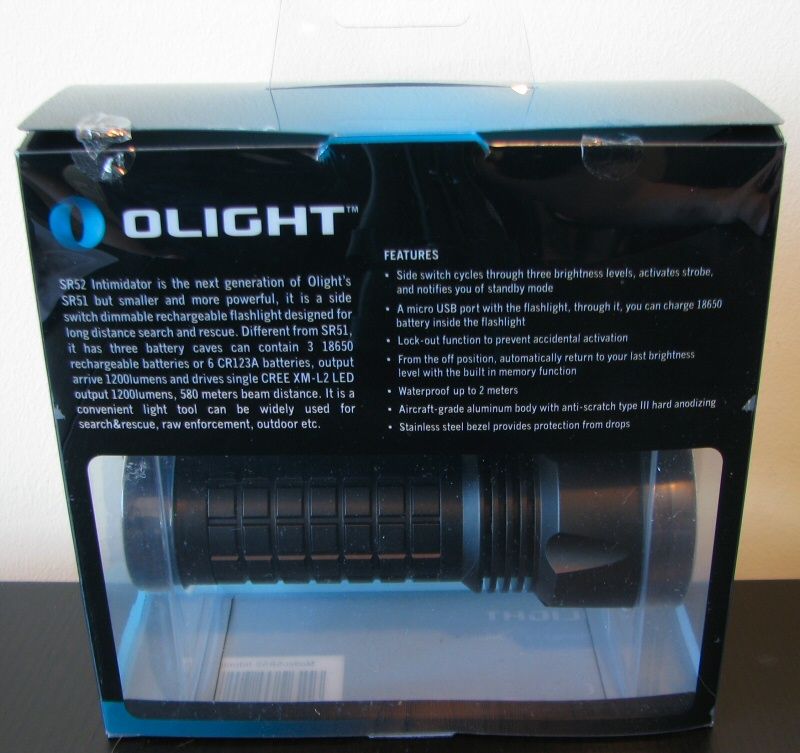
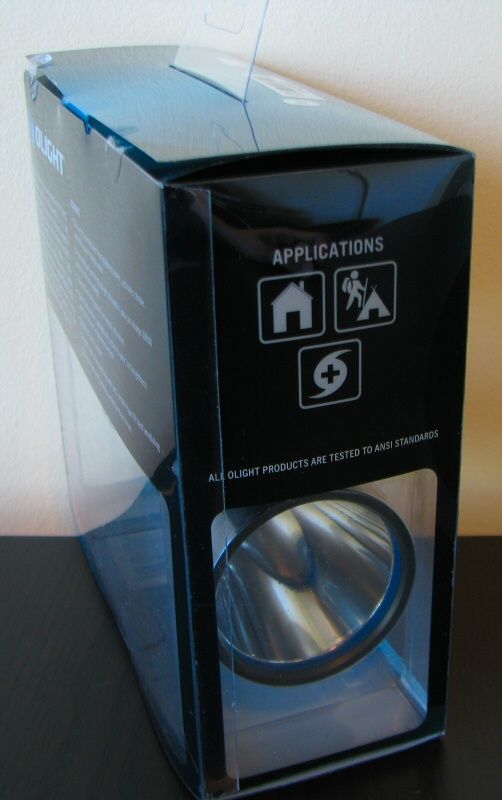
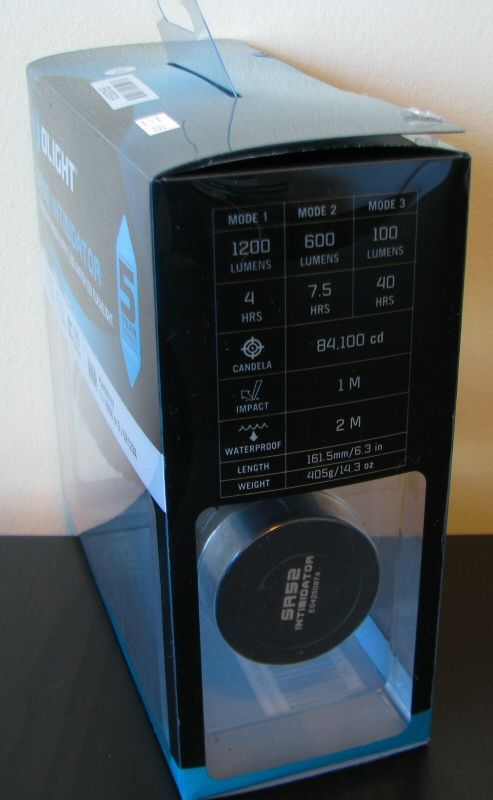
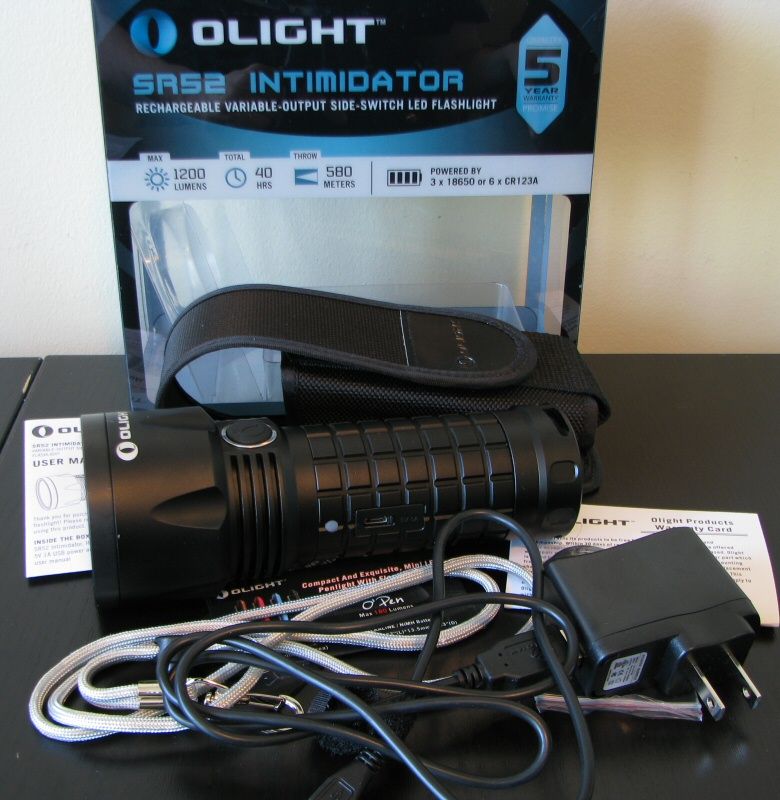
Retail packaging is the new style from Olight, which is virtually identical to Foursevens (not surprising, given the close connection between the companies). Printed on the sides and back are the key characteristics of the light. Inside, included with the light are spare O-rings, good quality lanyard, holster, micro-USB cable with AC adapter, warranty card and manual.
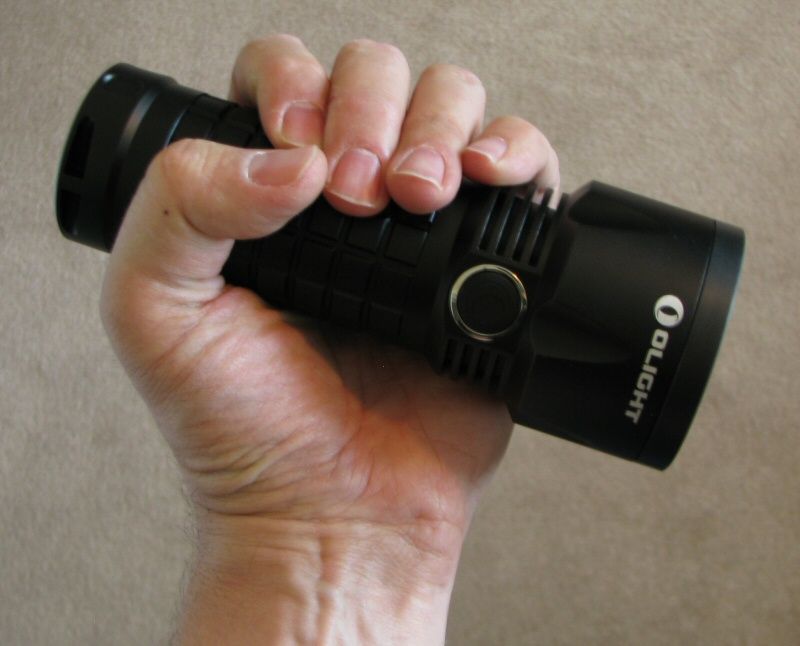
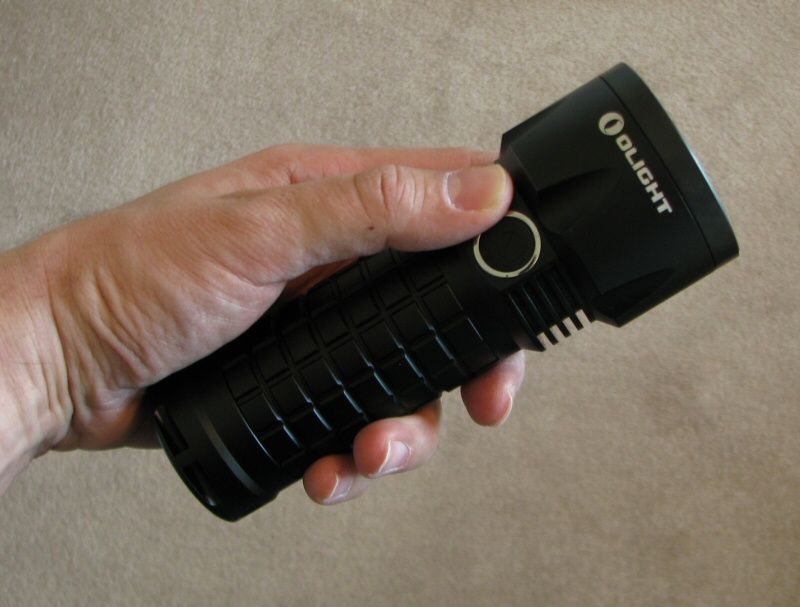
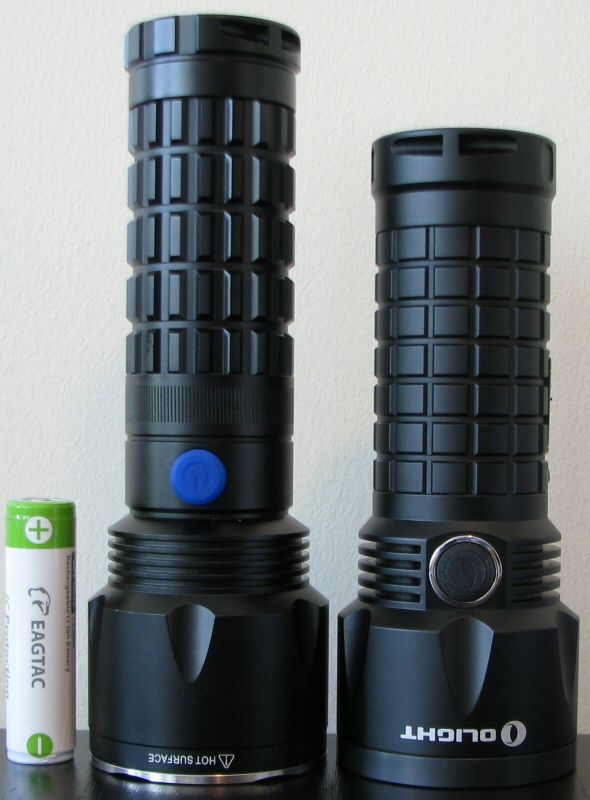
From left to right: Eagletac Protected 3100mAh 18650; Olight SR51, SR52.
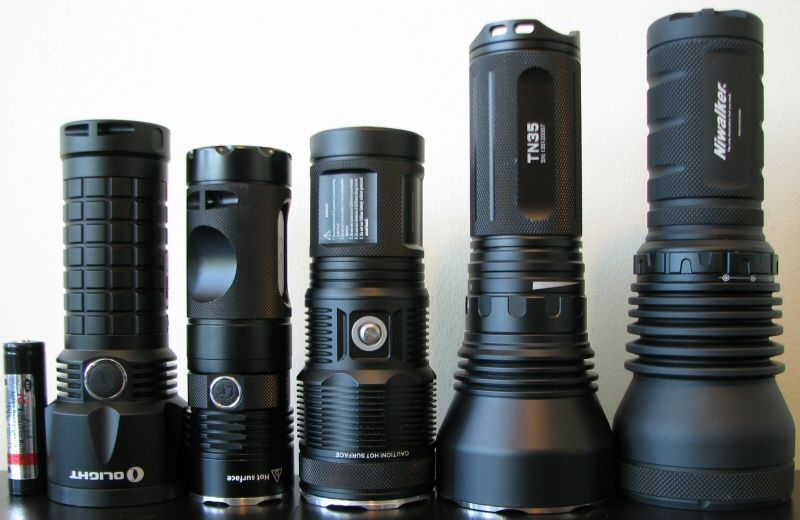
From left to right: AW Protected 18650 2200mAh; Olight SR52; Eagletac SX25L3; Nitecore TM15; Thrunite TN35; Niwalker BK-FA01.
All dimensions directly measured, and given with no batteries installed (unless indicated), and without the handle:
Olight SR52: Weight: 396.7g (497g with 6xCR123A), Length: 162mm, Width (bezel): 63.1mm
Olight SR51: Weight: 405.0g (505g with 6xCR123A), Length: 190mm, Width (bezel) 62.0mm
Olight SR Mini: Weight: 285.5g, Length: 126.9mm, Width (bezel): 48.1mm
ArmyTek Barracuda (XM-L2): Weight 400.8g, Length 264mm, Width (bezel): 64.0mm
Eagletac SX25L3: Weight: 315.9g, Length: 150.2mm, Weight (bezel): 47.0mm
Fenix TK61: Weight: 605.7g (790g with 4x18650), Length: 218mm, Width (bezel): 96.0mm
Niwalker BK-FA01 (XM-L2): Weight: 682.3g (864g with 4x18650), Length: 209mm, Width (bezel): 80.0mm, Width (tailcap): 50.3mm
SupBeam K50: Weight: 645.0g, Length: 230mm, Width (bezel): 90.1mm
Thrunite TN32 (XM-L2): Weight: 655.9g (808g with 3x18650), Length: 201mm, Width (bezel): 79.0mm
As you can see, the new SR52 is a lot shorter than the old SR51 – but the handle is wider now (to accommodate 3x18650).
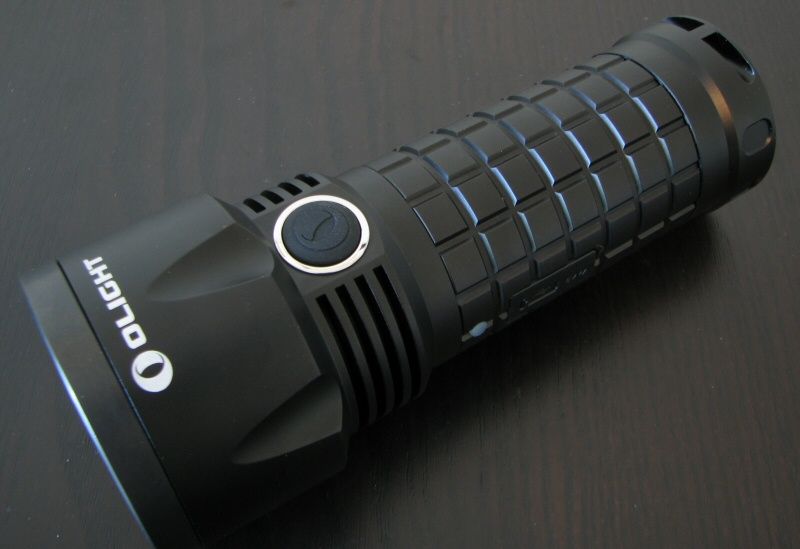
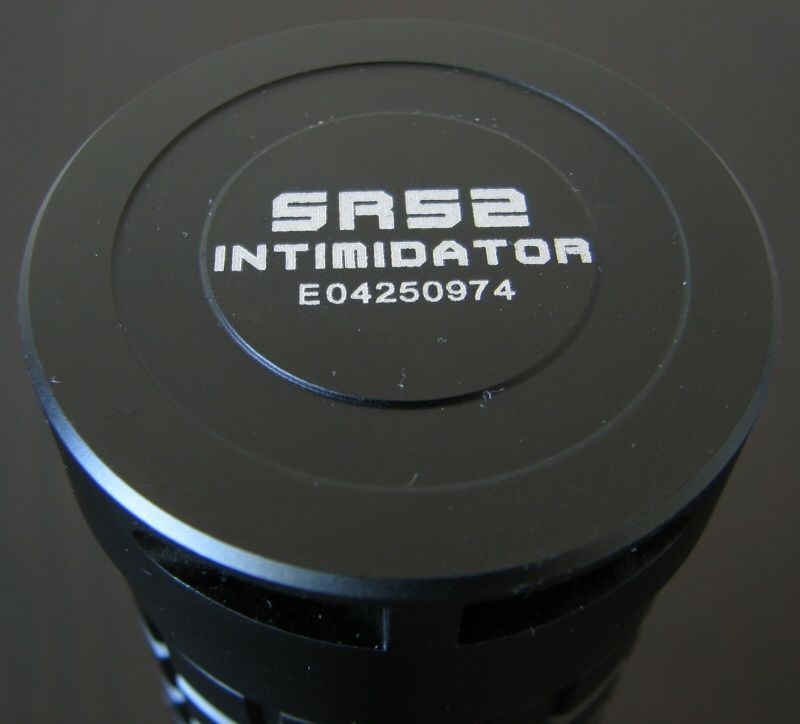
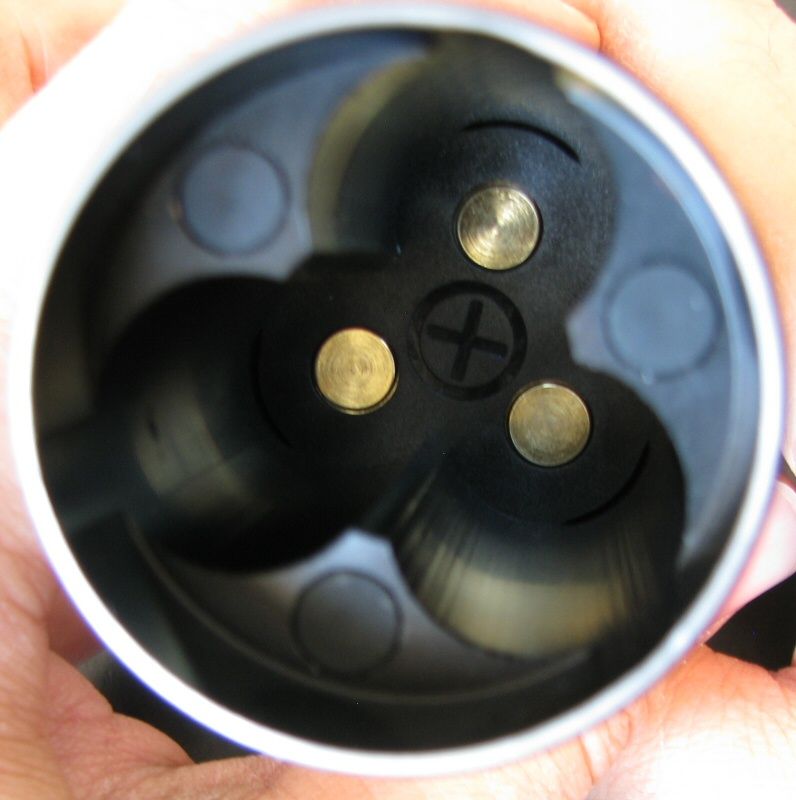
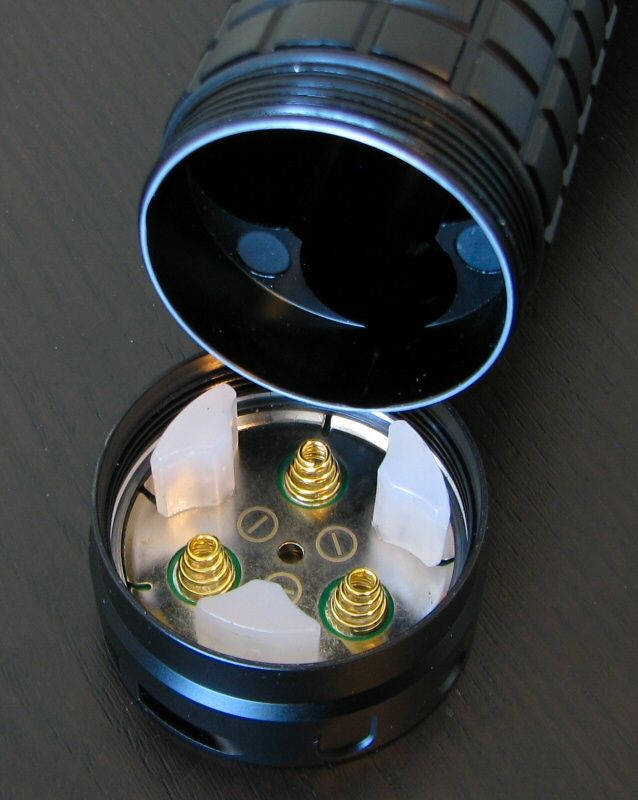
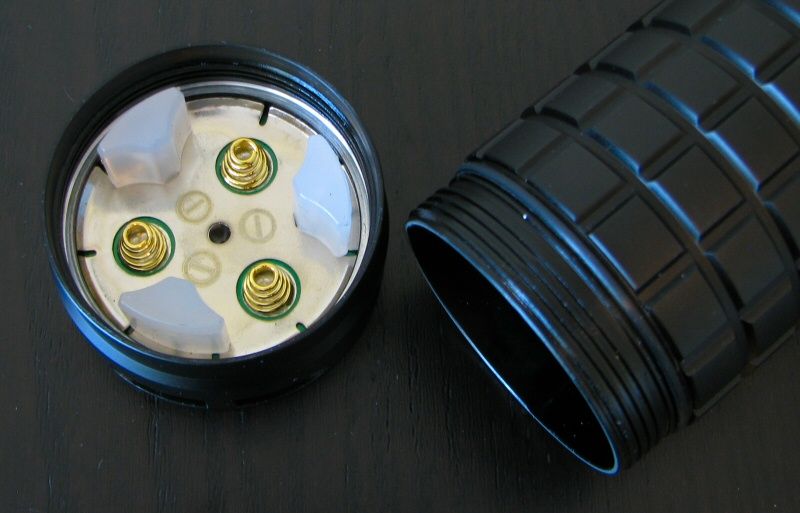
Build is reasonably compact for a 3x18650 thrower light – but of course, it has a larger head compared to the more traditional members of this class. It is certainly quite small by the typical Olight SR-series standards (outside the SR Mini, that is).
The SR52 feels solid and more substantial than the earlier SR51, due to the built-in cut-out wells for the batteries (i.e., no carrier is used any more). Anodizing is matte black finish. There is no real knurling to speak of, but there is a large checkered grid pattern all over the handle. Grip is pretty good.
Body labels are minimal, with most of the info on the tail cap. Lettering is bright white and clear against the black background.
The light opens at the tailcap only. Tail threads are square-cut, and anodized for lock out. Tailcap design is distinctive – there are three large plastic inserts to hold the tailcap internals in place as you screw down the tail. Unlike the SR Mini, the SR52 does indeed have the three batteries running in parallel (i.e., 1s3p), with the positive terminals of the cells all going toward the head. As a result of this arrangement, you could run the light on a reduced number of cells.
The built-in wells take all widths of 18650s in my collection. However, only button-top cells would reliably work in the light (i.e., the positive contact points in the head are not raised).
There is a raised hard soft rubber switch for on/off. Switch feel and traverse are about typical for this class. Scroll down for an interface discussion.
One of the more interesting new features of the SR52 is the in-light charging option:
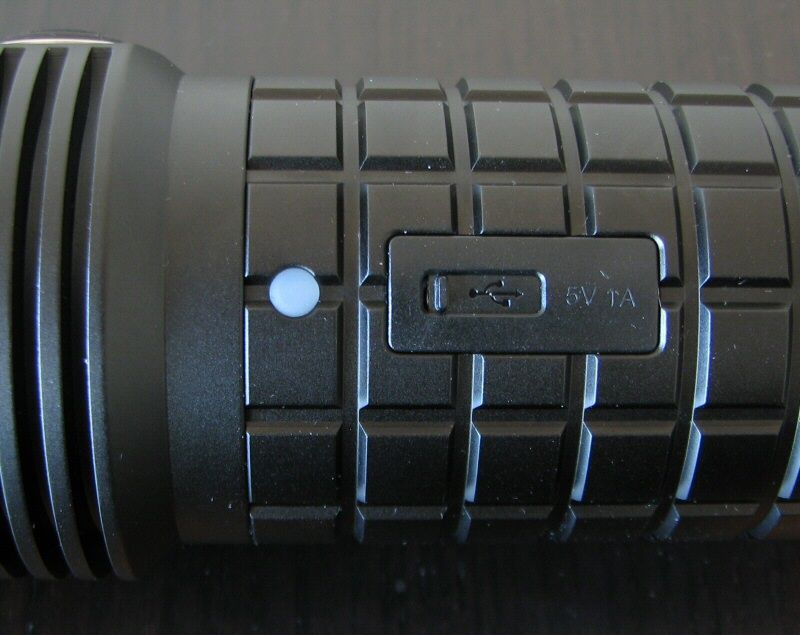
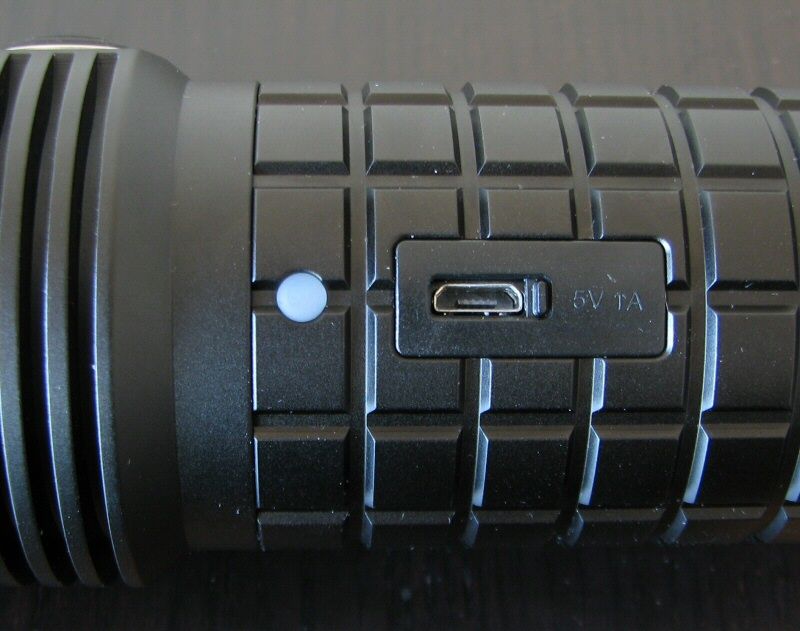
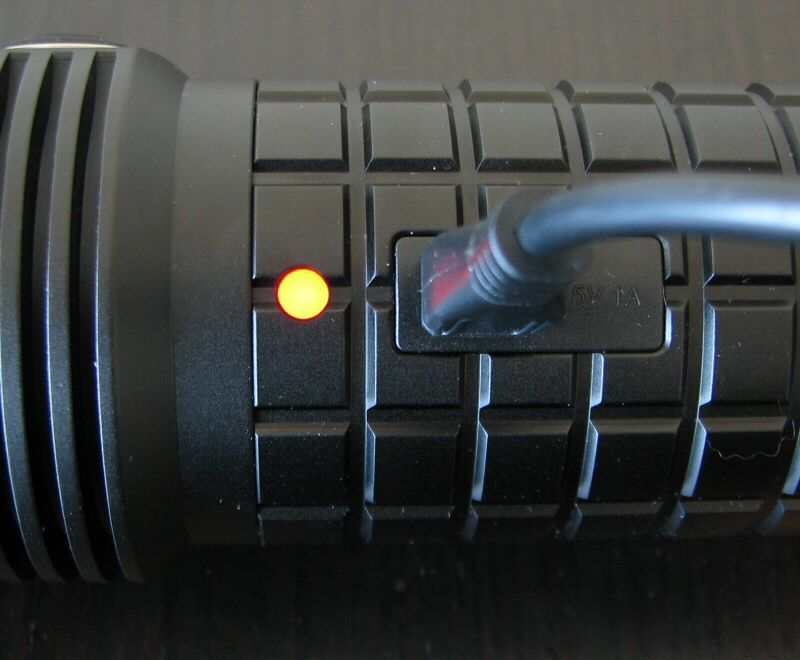
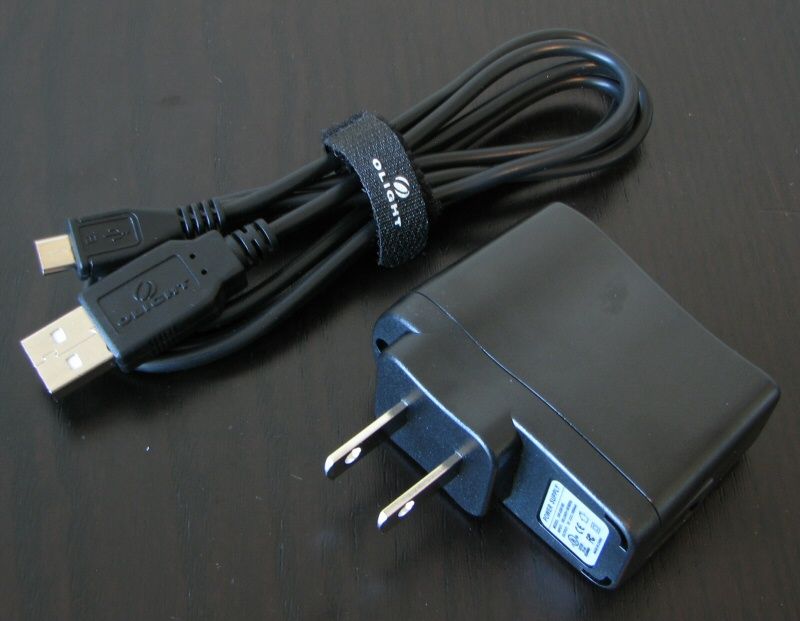
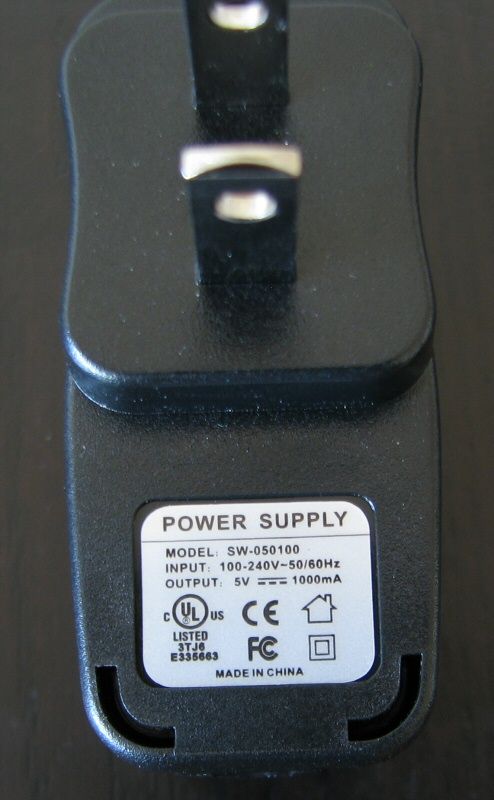
As you can see, there is a small micro-USB port hidden behind a sliding cover. When you plug the light into a power source, the LED indicator beside the port will light up red (to indicate charging). It goes green once the charger terminates.
Bundled with the light is a USB-AC adapter, rated at up to 1A charge current. Please see my charging analysis later in this review.
One comment here – due to the parallel well arrangement, you could run the light on a reduced number of cells (i.e., 2x18650/4xCR123A or even 1x18650/2xCR123A). Of course, this will produce lower runtimes. Similarly, you could charge the light on 1x, 2x, or 3x 18650 – the difference is that the light will charge much faster on fewer cells (since the current won't need to be split across the cells). Again, scroll down for more info.
Let's take a look at the head:
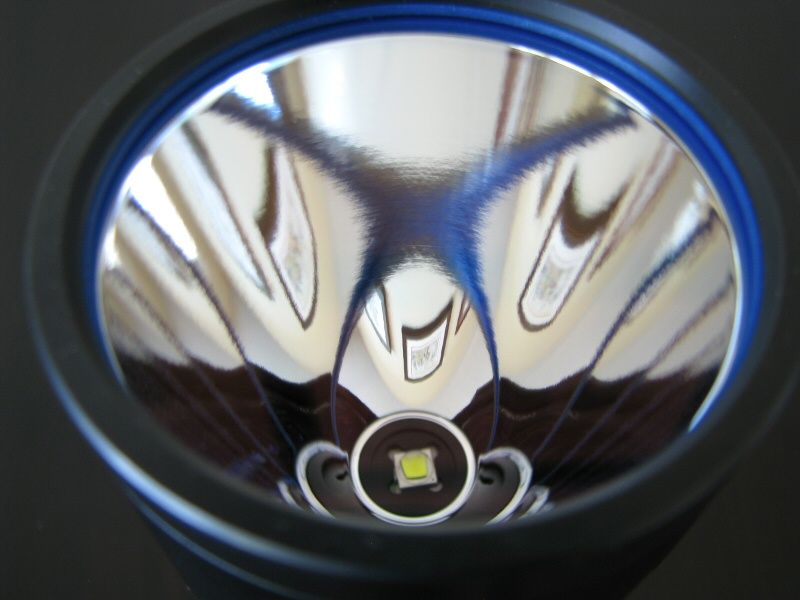
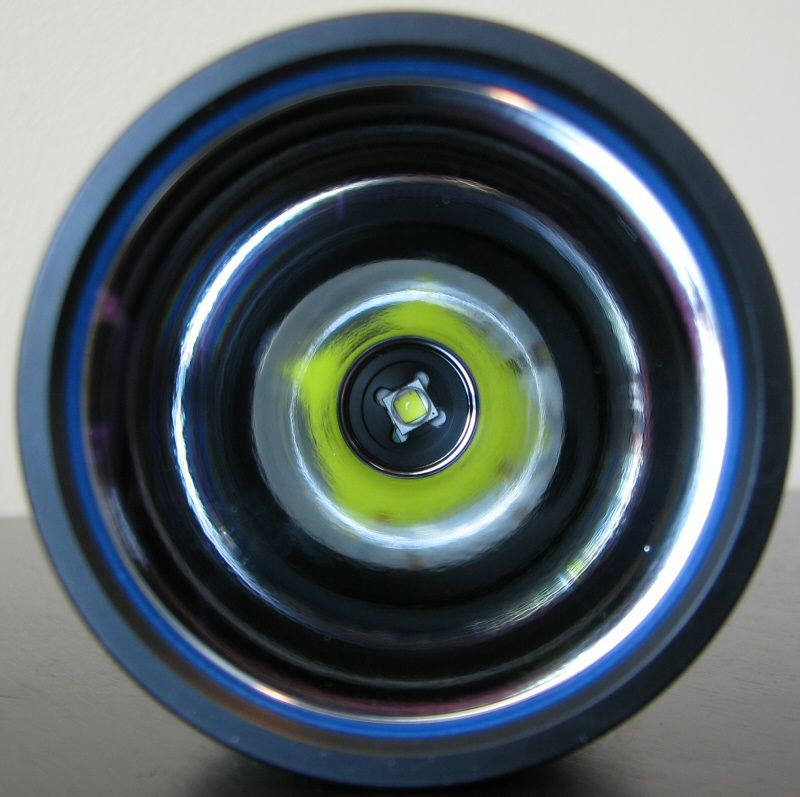
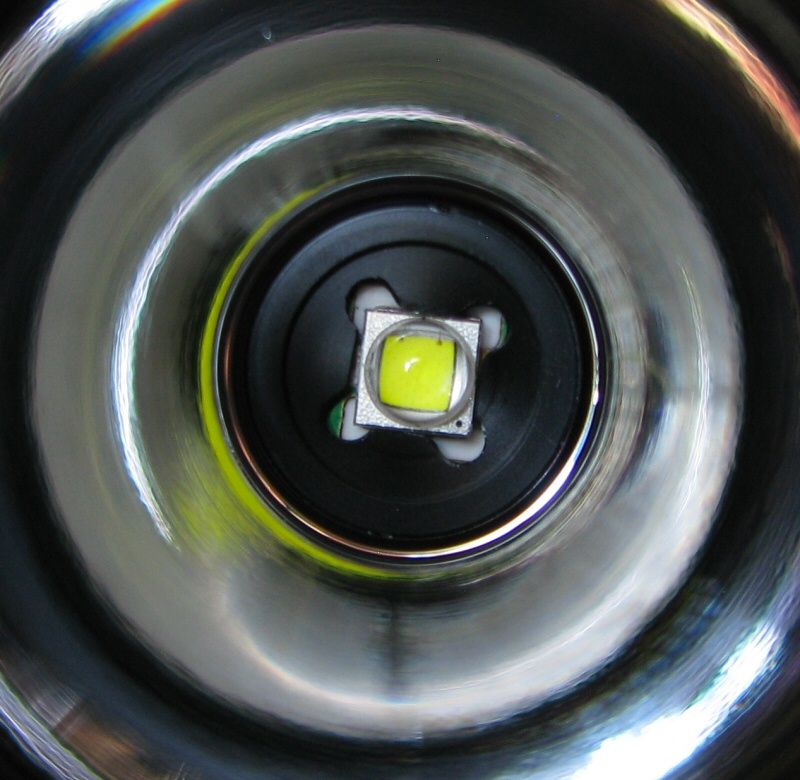
The XM-L2 emitter is at the base of a large smooth reflector. Despite the use of a centering mask, by emitter was distinctly off-center somewhat on my sample. This was not enough to significantly affect the beam pattern, but it does suggest that peak intensity throw could likely be improved upon from my sample. There is a blue o-ring between the lens and bezel now (which seems to glow for a little while after being lit,
By the way, in case you are wondering how the SR52 compares to the original SR51 (on the left below):
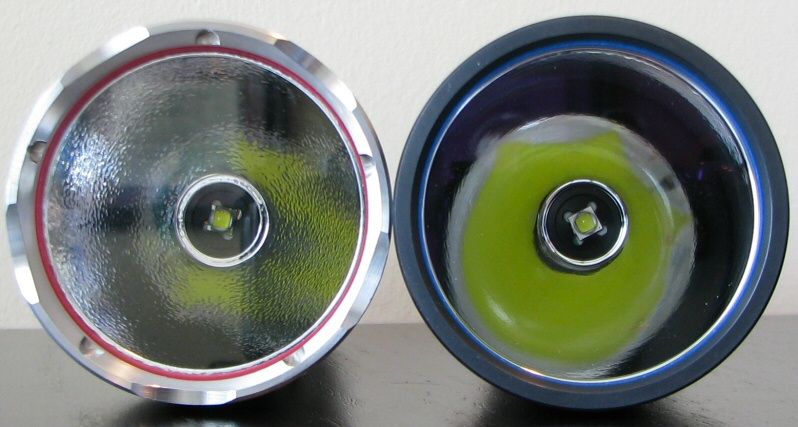
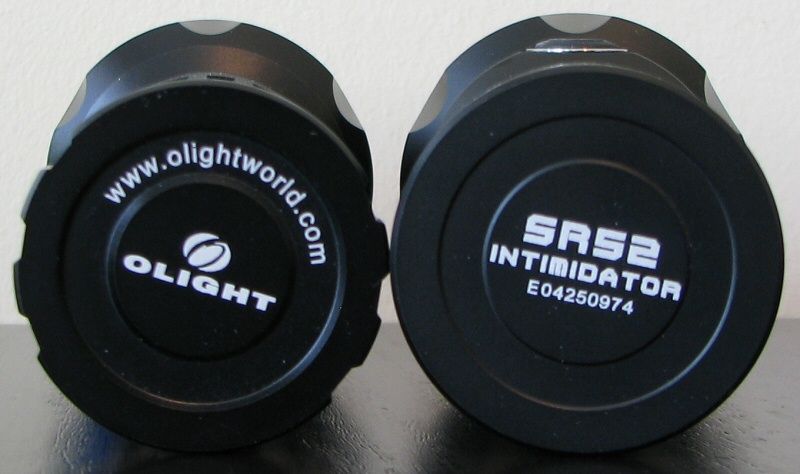
You can't really see it above, but the SR52 (on the right) has a slightly wider and deeper reflector than the SR51. Combined with the smooth finish and higher circuit output, this should translate into noticeably improved center beam throw. Scroll down for beamshot comparisons and direct beam measures.
User Interface
Turn the light on/off by the electronic switch.
Turn the light on or off by a single click of the switch (i.e., press-release).
Change output modes by pressing and holding the switch. Mode sequence is Lo > Med > Hi, in a repeating loop (release the switch to select). The light has mode memory, and returns to the last level used after off-on.
Double-clicking the switch from on or off gives you the strobe mode.
There is a lock-out mode – hold the switch down for >2 secs from Off, and the light will turn itself off and be locked out (note that it comes on during those 2 secs in the previously memorized mode). You can unlock the light by holding the switch down for ~1 sec (which isn't that much of a lockout, really). Although oddly, memory of being locked out persists even after a battery change.
Video:
For more information on the overall build and user interface, please see my video overview:
As with all my videos, I recommend you have annotations turned on. I commonly update the commentary with additional information or clarifications before publicly releasing the video.
PWM/Strobe
Reviewer's note: I have recently updated my oscilloscope software, so the traces below may look a little different from my earlier reviews.
There is no sign of flicker or PWM that I can see, at any output level – I believe the light is current-controlled.
Strobe:
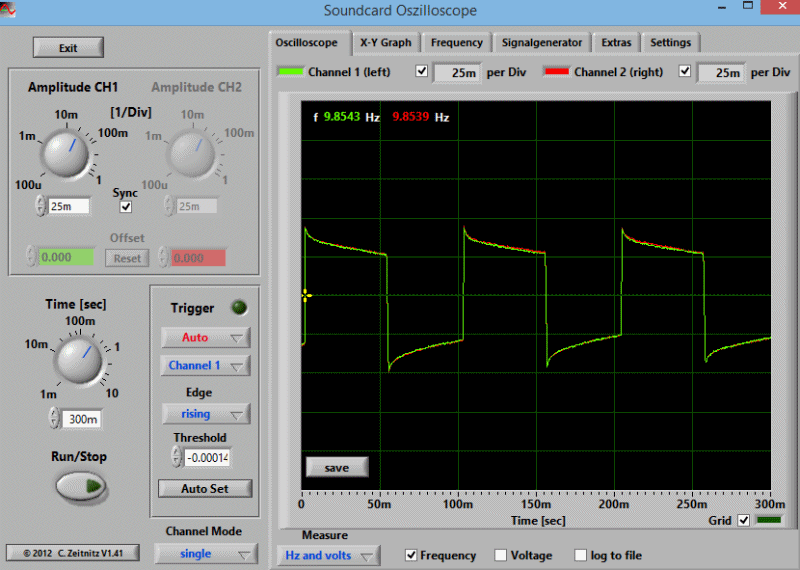
The strobe mode was a fairly typical ~10Hz fast strobe.
Charging Current
Because the AC charger uses a USB connector to the charging cable, I was able to take direct measures of the charging parameters. For these measures, I am using the new Xtar VI01 "USB Detector" (basically a specialized USB current/voltage meter). This model has recently been favorably reviewed by HKJ here.
For charging tests, I started with discharged AW protected 18650 cells, measuring ~2.8-3.0V at rest (i.e., heavily depleted). For all these tests, I left the USB detector in place for all readings. Note that the voltage reading on this device refers to the input voltage (i.e., from the charging brick).
Initial charging current and input voltage:
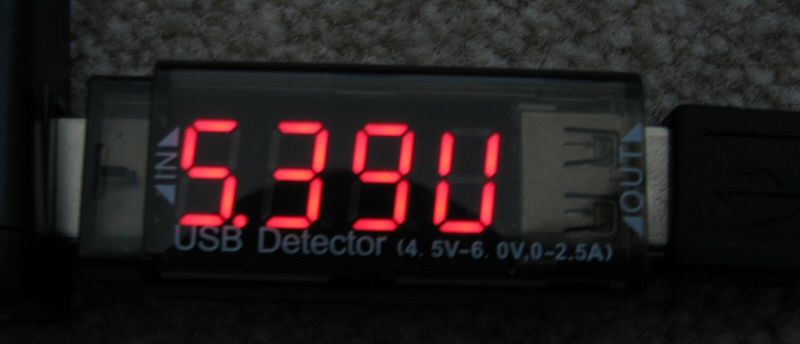
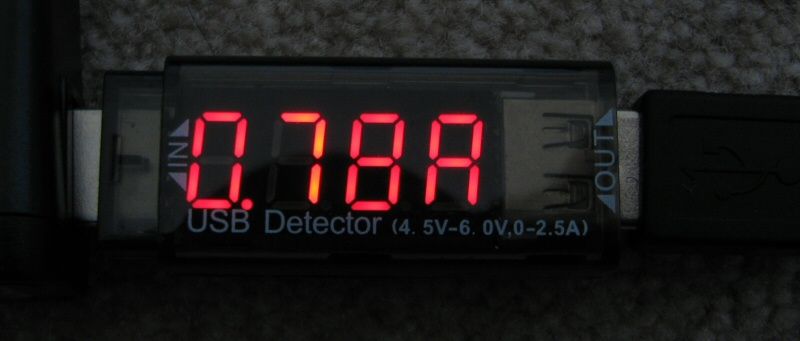
As you can see, charging started at 0.78A with a typical USB ~5.4V input voltage ("U" is meant to represent Volts on the top display above). Recall that the AC adapter has a max charging rate of 1A and 5VDC. I won't bother continuing to show the input voltage, since it doesn't change much over the charge cycle (ranged from ~5.36V at the lowest charging current, to ~5.43V at the highest).
After 30 mins of charging, the charging current was up to:
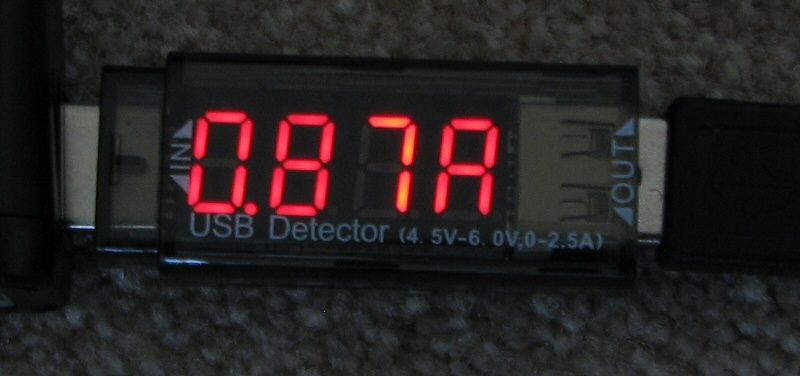
~0.87A at this point. Depending on how depleted your cells were to start, you may find an initial charging current somewhere between this current and the one reported above (e.g., I got ~0.82A initial current when the cells were all between ~3.2-3.4V to start)
After 4 hours of charging:
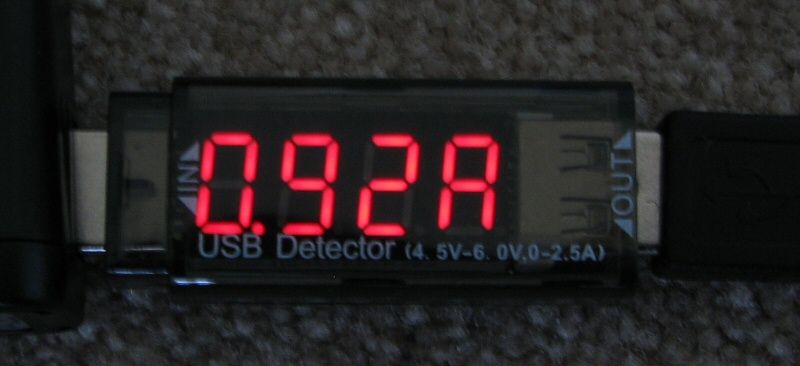
Charging current has reached ~0.92A. In my testing, the charger appeared to peak ~0.95A.
After 5 hours and 30 mins of charging:
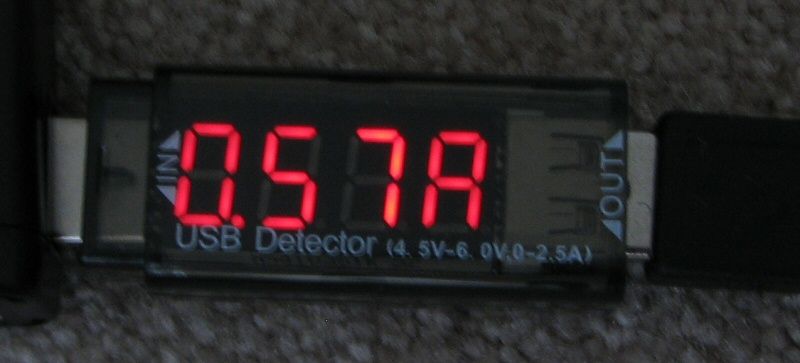
You can see charging has dropped out of the Constant Current (CC) phase, and is now charging at a much lower rate (~0.57A).
The charging indicator went green and the current dropped to zero after a charging time of ~7 hours.
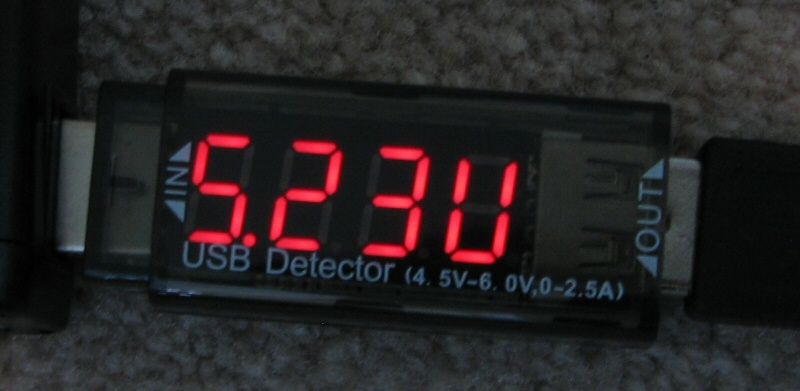
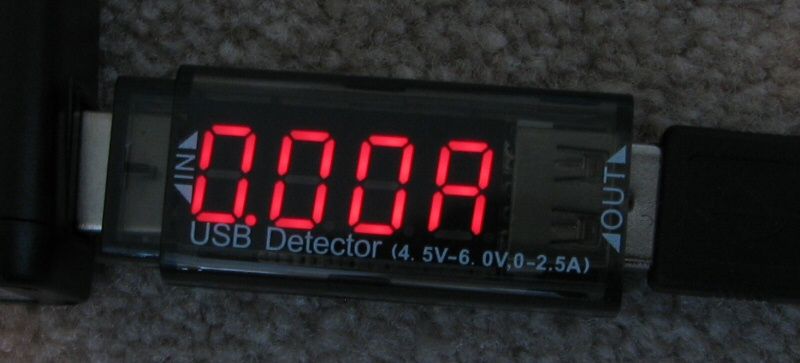
Resting voltage of the AW 2200mAh batteries was ~4.19-4.20V at this point. This is very reasonable charging time and acceptable resting voltage at termination.
For second attempt on 3x 3100mAh cells, it took ~10 hours to fully charge the cells. All three cells came out reading ~4.19V. :thumbsup:
The above is what I would have expected. However, I did encounter a problem on one charge cycle attempt on 3x 2200mAh cells - the charger indicated fully charged after only ~5 hrs and 30mins. :thinking: When I measured the resting voltage of the cells, one showed an abnormally low voltage of ~3.81V, with the other two having the typical ~4.19-4.20V. Of course, since the charger charges in parallel, it terminates once the highest voltage cell reaches ~4.2V. But it appears that one cell on this attempt had only intermittent contact. Note that all three cells were ~3.0V at the start of the charge cycle.
I will come back to this issue later in the Runtimes section of the review, but I recommend you re-confirm the voltage of all cells with a DMM after charging in the SR52.
Standby Drain
A standby current drain is inevitable on this light, due to the electronic switch. As the body design appears, the three wells are run in parallel (i.e. 1s3p arrangement).
When first connecting the leads, my DMM reports ~155uA standby drain – but this immediately drops to a ridiculously low 2uA. This standby drain is stable on my SR52, suggesting the cells would self-discharge long before you actually drained them in this light. :thumbsup:
Note that the lock-out mode has no effect on the standby current. But you can always lock out the light physically by a simple turn of the tailcap.
Beamshots:
And now, what you have all been waiting for. All lights are on their standard battery, or AW protected 18650 2200mAh for the multi-18650 lights. Lights are about ~0.75 meter from a white wall (with the camera ~1.25 meters back from the wall). Automatic white balance is to minimize tint differences.
All lights are on their standard battery, or AW protected 18650 2200mAh for the multi-18650 lights. Lights are about ~0.75 meter from a white wall (with the camera ~1.25 meters back from the wall). Automatic white balance is to minimize tint differences.
Let's start with a comparison of the SR52 to the original SR51 – and the recent SR Mini (in the ~1200 lumen Hi mode):
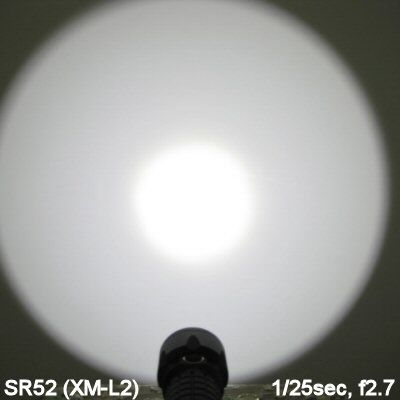
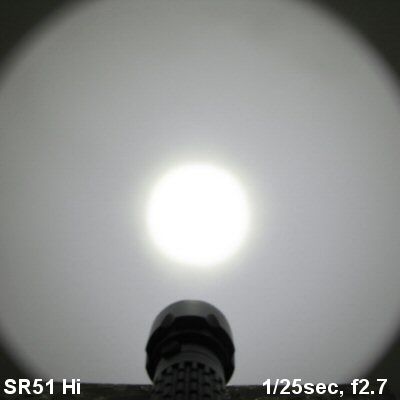
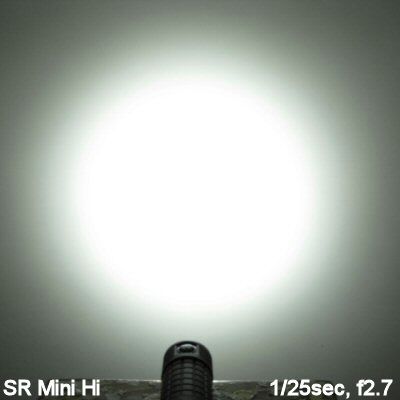
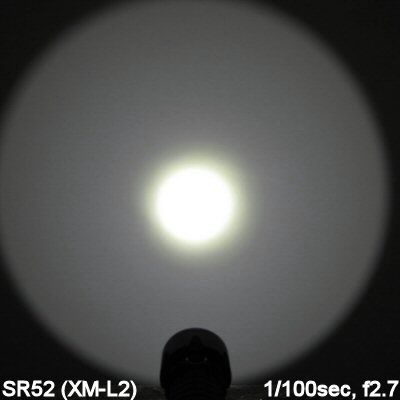
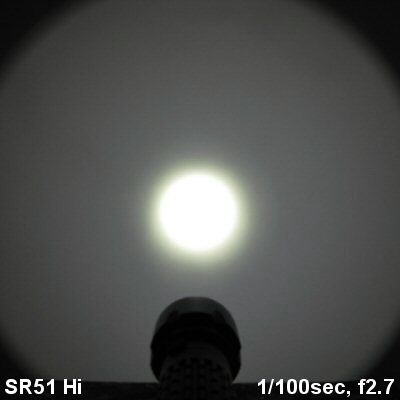
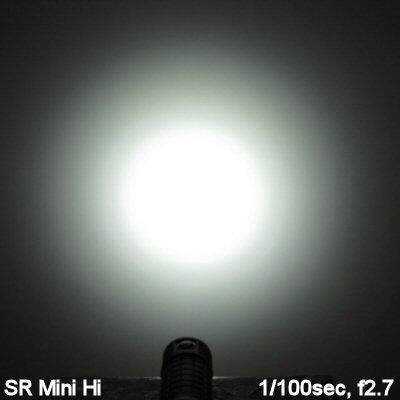
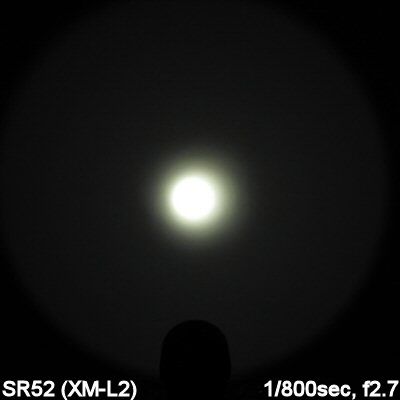
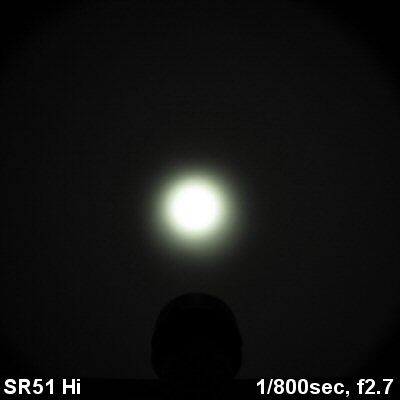
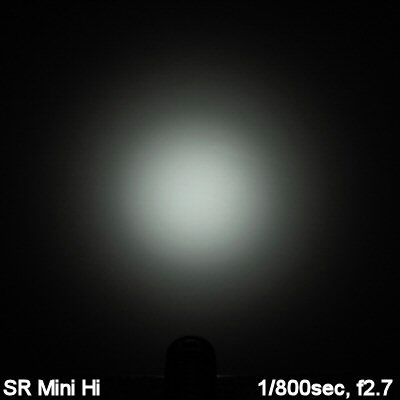
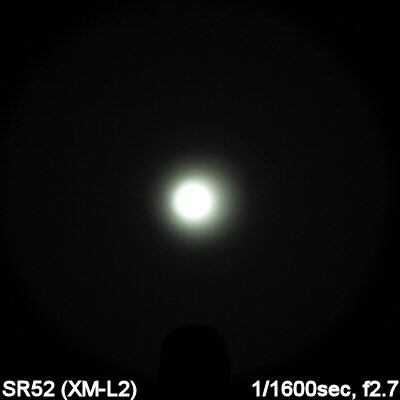
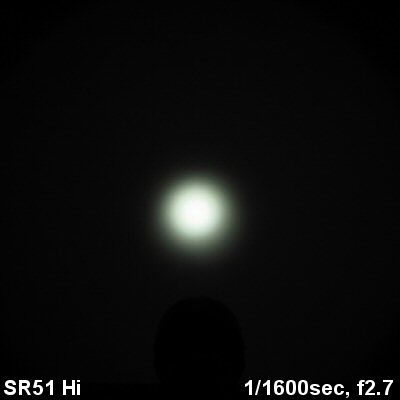
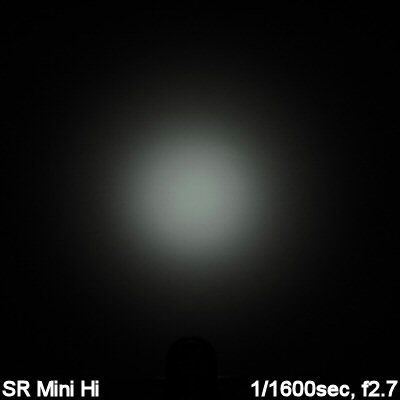
The SR52 definitely has more overall output than the SR51, and greater center-beam throw. The latter is due to a combination of greater output and slightly better focusing now (likely due to the smooth reflector). It is hard to compare to the full flood SR Mini, but the output levels between the SR Mini and SR52 Hi levels are pretty similar above.
And what about the recent XM-L2 thrower competition?

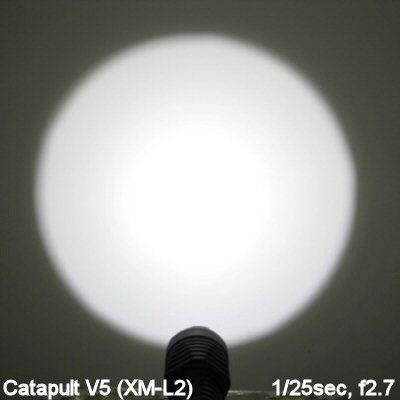
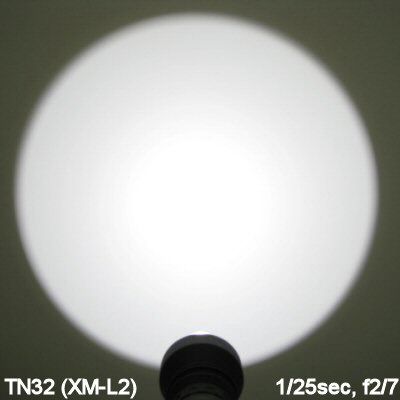
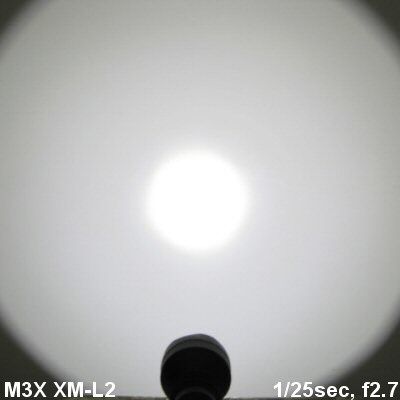

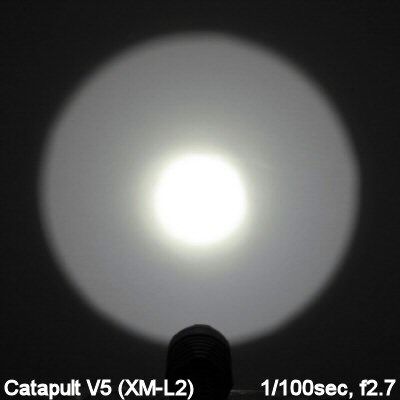
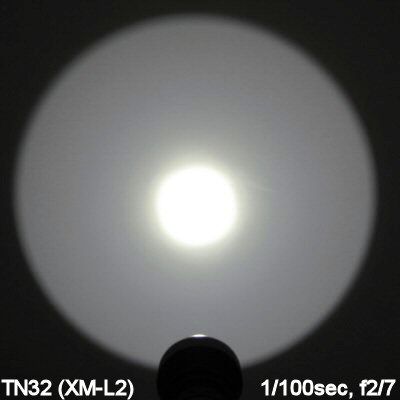
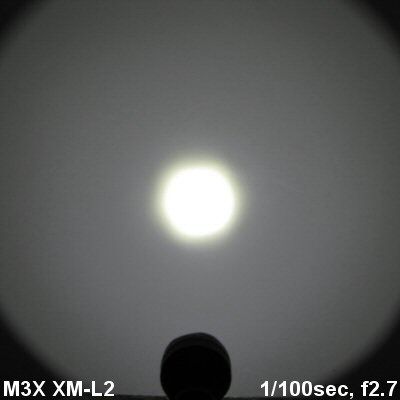

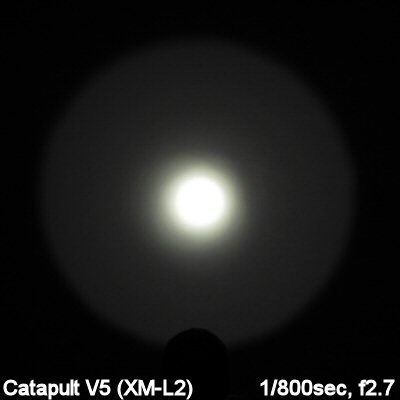
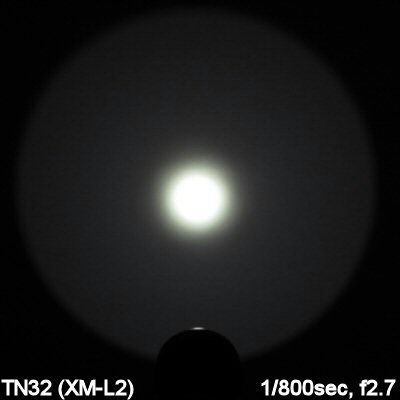
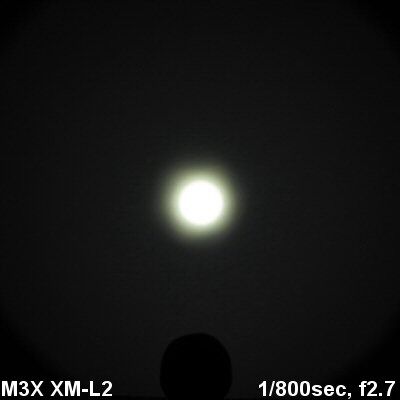

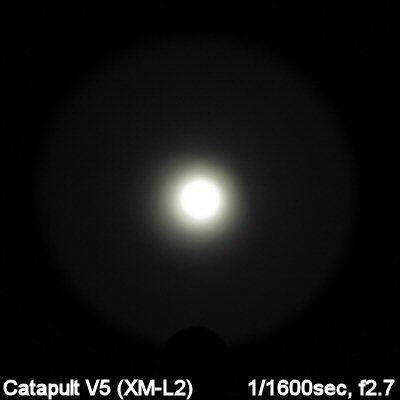
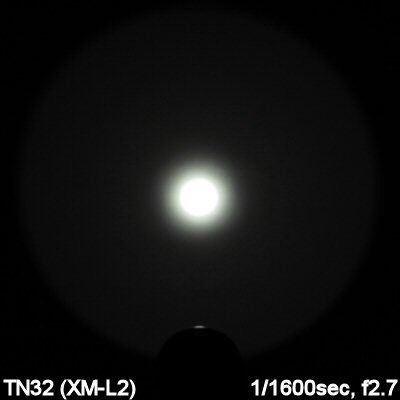
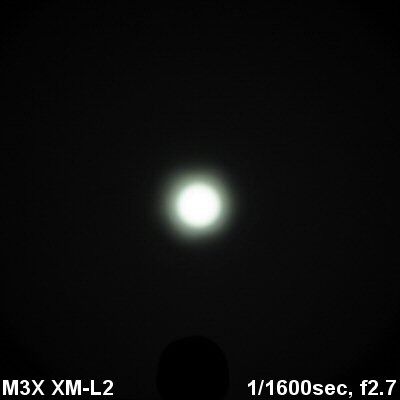
The above are all such strong throwers, it is hard to meaningfully compare their center beams above. Please scroll down to my direct output measures for more info.
For outdoor shots, these are done in the style of my earlier 100-yard round-up review. Please see that thread for a discussion of the topography. In order to compare the various tints of different lights, I have locked the camera to Daylight (~5200K) white balance.
FYI, any squiggly trails you see in the light beams are due to flying insects (and the long shutter time). :wave:
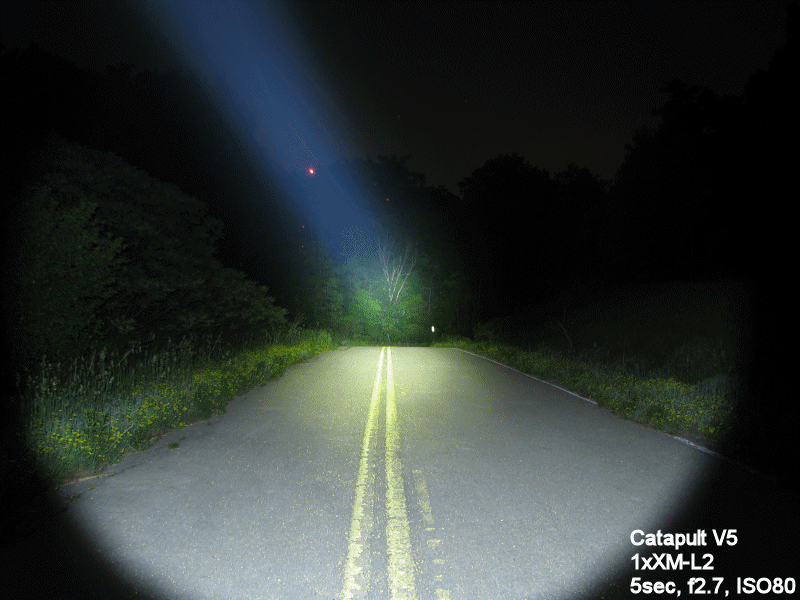

Although it looks like the Catapult V5 has a throw advantage over the SR52, this is slightly misleading due to the higher output of the Cat V5. While the Cat V5 has a broader hotspot, peak center beam intensity is not that much higher. There is no denying how much brighter both these lights are against the original SR51 though.
Again, scroll down for direct measures.
Testing Method:
All my output numbers are relative for my home-made light box setup, as described on my flashlightreviews.ca website. You can directly compare all my relative output values from different reviews - i.e. an output value of "10" in one graph is the same as "10" in another. All runtimes are done under a cooling fan, except for any extended run Lo/Min modes (i.e. >12 hours) which are done without cooling.
I have devised a method for converting my lightbox relative output values (ROV) to estimated Lumens. See my How to convert Selfbuilt's Lightbox values to Lumens thread for more info.
Throw/Output Summary Chart:
My summary tables are reported in a manner consistent with the ANSI FL-1 standard for flashlight testing. Please see http://www.flashlightreviews.ca/FL1.htm for a discussion, and a description of all the terms used in these tables. Effective July 2012, I have updated all my Peak Intensity/Beam Distance measures with a NIST-certified Extech EA31 lightmeter (orange highlights).
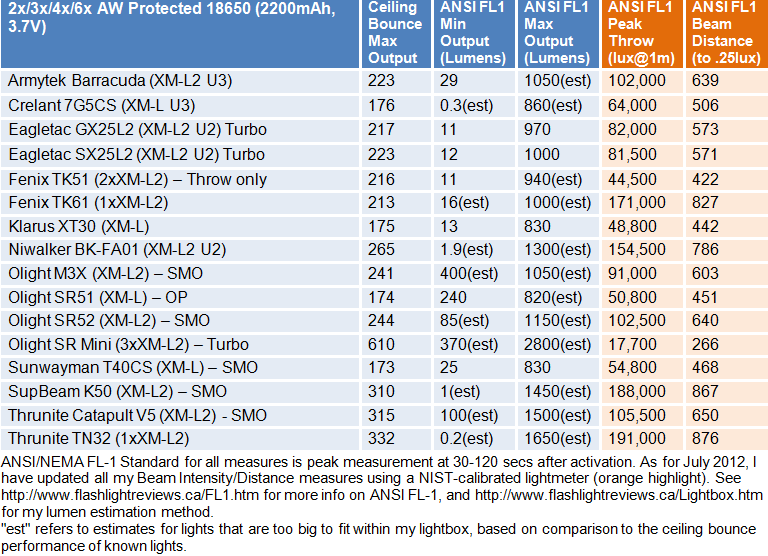
Interestingly, while the SR52 only seems to be ~40% brighter than the SR51, it has about double the peak beam intensity. oo:
oo:
The SR52 is basically equivalent to the Olight M3X, Armytek Barracuda and Thrunite Catapult in terms of peak beam intensity (although is lower in overall output than the Cat V5).
Let's see how the rest of the output levels compare:
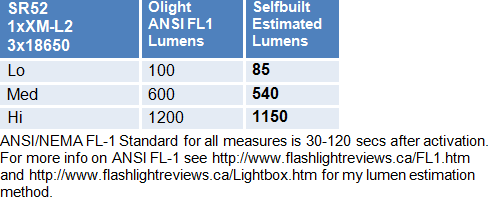
Overall, there is a pretty close concordance between my estimates and the published specs.
Output/Runtime Graphs:
As always, all runtimes are done under a cooling fan:
Let's start with a Hi mode comparison of my standard AW protected 2200mAh cells, against the more common Panasonic NCR18650B 3100mAh cells (Xtar protected in this case):
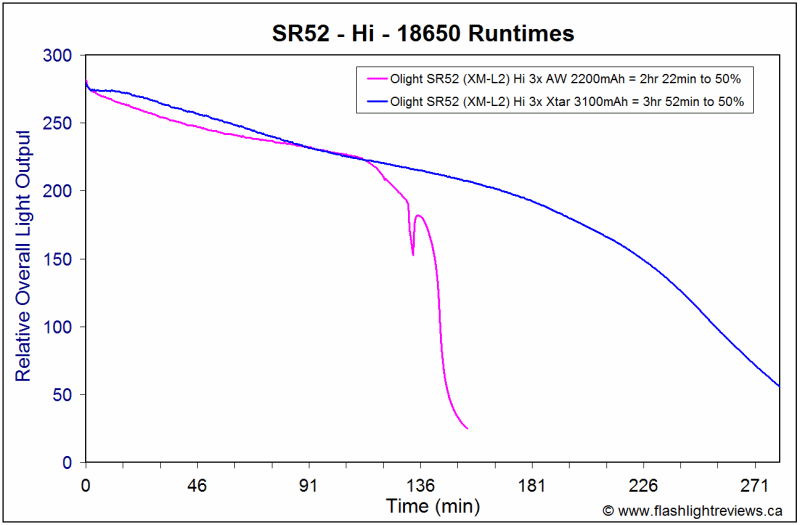
And now against other lights, using my standard runtimes below are done on AW protected 18650 2200mAh cells.
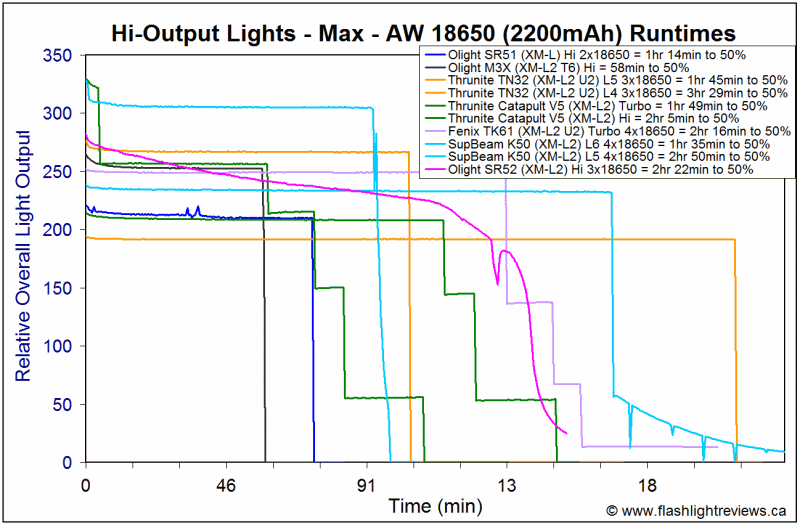
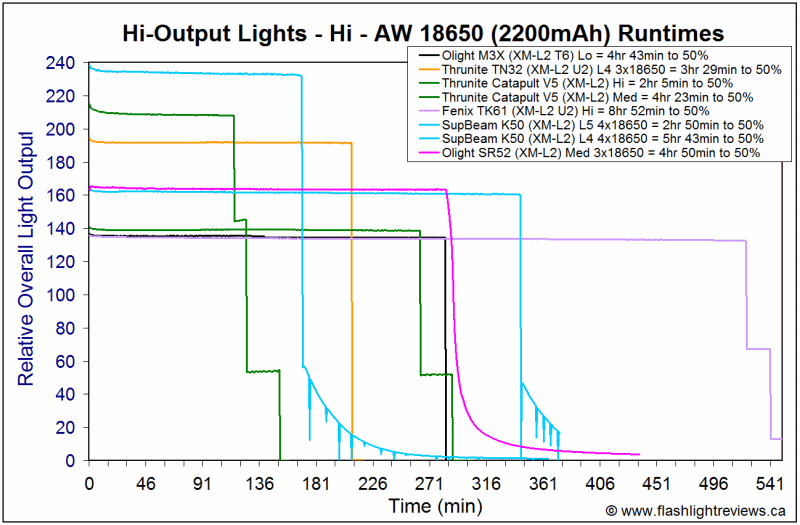
Overall output/runtime efficiency is excellent on 3x18650. The SR52 show perfectly flat stabilization on Lo/Med, but has a largely direct-drive like pattern on Hi (after a variable period of flat stabilization, depending on the battery type). This is not uncommon in multi-power lights, but it is a departure from the fully flat-stabilized SR51.
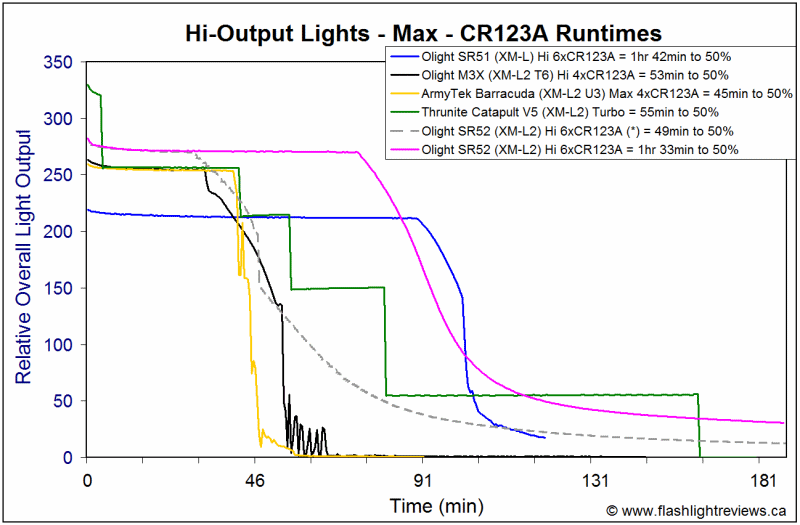
Performance on CR123A above takes a little explaining. The solid line shows you what you would expect for 6xCR123A on Hi in this light – roughly equivalent output and runtime to my 3x18650 cells, but with fully flat-regulated output. You also see a nice output increase over the SR51, for equivalent runtime. :thumbsup:
So what is up with the dotted gray line and the "(*)"? That was my first attempt at a 6xCR123A runtime – notice the greatly reduced runtime, consistent with a typical 4xCR123A XM-L2 light driven to these levels? This led me to suspect that I was having the same problem identified in the 18650 charging section of this review – one of the three wells was not making proper contact.
Upon examining the cells after this run with a ZTS battery tester, I confirmed that two of CR123As in one well registered as still 100% charged. It thus seems that the dotted line run above only ran on 4xCR123A (across two wells, ignoring the third). This doesn't affect max output, but it does drastically affect runtime (i.e., you are running those four cells pretty hard).
Clearly, this intermittent contact issue is a potential concern. I am not clear as to the source of the problem, as I seem to be getting a good connection at all contact points (as tested with a DMM). I'm thinking it may have been a bit debris or build-up on one of the contact surfaces, so I have given everything a thorough cleaning with a contact cleaner. So far, over half a dozen runtimes and/or charging cycles, I have seen no reoccurrence of this issue.
Potential Issues
Flat-top cells cannot be used in the light, given the flat contacts in the head.
There is a standby drain when the tailcap is fully connected, but this is ridiculous low at 2uA, and will not impact the charge status of your cells. There is also an electronic and physical lock out option.
There was an intermittent contact issue early on with one well on my sample. This manifested as either reduced runtime (i.e., that well was not engaged on one runtime test), or reduced charging time (i.e., that well was not recharged on one 18650 charge cycle attempt). I have thoroughly cleaned all contact surfaces, and I have not seen a re-occurrence of the problem on the last half dozen or so runs or charge cycles.
Preliminary Observations
The SR52 is a nice update to the SR51, with considerably improved center beam throw and (to a lesser extent) greater overall output. It is also a more compact offering, with a significantly shorter body (although slightly wider, to accommodate a third 18650 cell). And even more surprising given the reduced length – an in-light 18650 battery charging feature has also been added. oo:
oo:
Build-wise, the SR52 fits in very well with the traditions for the SR-series class from Olight. I like that the dual battery carriers of the SR51 are now gone (i.e., it had separate ones for 6xCR123A and 2x18650). The built-in battery wells on the SR52 are appreciated – as is the parallel cell arrangement. This is not something you see very often, but is very advantageous for in-light charging (i.e., much safer than in-series charging).
On that note, the charger did well in my testing, showing an apparent CC/CV-like pattern (as near as I can tell). That said, I did experience one case of an apparent contact issue that led to incomplete charging of one of the three 18650 cells, so I recommend you double-check the charge status of each cell with a DMM afterwards.
I like the user interface of the SR52, which is similar to the original SR51. Very intuitive and straight-forward, with no surprises.
Output/runtime performance of the SR52 was in keeping with my expectations for a good current-controlled light. The light was generally flat-stabilized (although not for very on long on the Hi mode with 18650). Of course, you would not be able to see the gradual drop-off in output, so I still consider this a positive for runtime efficiency.
In terms of the beam, the SR52 is a great thrower – right up there with the best 2x18650 XM-L2 lights that use a similarly sized reflector.
At the end of the day, the SR52 is a great upgrade for a SR-series from Olight - with significant output and throw increases over the SR51 (not to mention the addition of in-light in-parallel charging). :thumbsup: I definitely consider this to be a top pick in the compact thrower class today.
----
SR52 provided by GoingGear on behalf of Olight for review.


The SR52 is an updated version of the portable SR-series thrower model from Olight – now supporting 3x18650 as well as 6xCR123A. There have been some pronounced design changes from the earlier model SR51. There are also quite a few differences from the concurrent 3x18650 SR Mini flood-style light as well.
Let's see how it compares to everything …
Manufacturer Reported Specifications:
(note: as always, these are simply what the manufacturer provides – scroll down to see my actual testing results).
- LED: 1 x Cree XM-L2 CW
- Light output / runtime: Hi: 1,200 lumens / 4 hrs – Med: 600 lumens / 7.5 hrs - Lo: 100 lumens / 40 hrs - Strobe: 1,200 lumens / 8 hrs
- Max beam distance: 580 meters
- Peak beam intensity: 84,100 cd
- VOLTAGE: 3V to 9V
- BATTERY SOURCE: 3 x 18650, 6 x CR123A
- Side switch cycles through three brightness levels and activates strobe
- A micro-USB port allows rechargeable batteries to be charged while inside the light
- A battery power LED indicator notifies you when light is fully charged and when batteries are low
- From the off position, automatically return to your last brightness level with the built-in memory function
- Lock-out function to prevent accidental activation
- LENS: Tough ultra-clear tempering glass with anti-reflective coating
- Waterproof up to 2 meters
- Impact resistant up to 1 meter
- Aircraft-grade aluminum body with anti-scratch type III hard anodizing
- DIMENSIONS: Length: 6.3in / 161.5mm, Bezel Diameter: 2.5 in / 63mm, Weight: 14.3 oz / 405 g (without batteries)
- WARRANTY: Olight's 5 Year warranty. Visit olightworld.com/warranty
- ACCESSORIES: Spare O-rings x 2, Holster x 1, 5V 1A USB power adapter x 1,
USB Cable x 1, lanyard x 1 - MSRP: $120





Retail packaging is the new style from Olight, which is virtually identical to Foursevens (not surprising, given the close connection between the companies). Printed on the sides and back are the key characteristics of the light. Inside, included with the light are spare O-rings, good quality lanyard, holster, micro-USB cable with AC adapter, warranty card and manual.



From left to right: Eagletac Protected 3100mAh 18650; Olight SR51, SR52.

From left to right: AW Protected 18650 2200mAh; Olight SR52; Eagletac SX25L3; Nitecore TM15; Thrunite TN35; Niwalker BK-FA01.
All dimensions directly measured, and given with no batteries installed (unless indicated), and without the handle:
Olight SR52: Weight: 396.7g (497g with 6xCR123A), Length: 162mm, Width (bezel): 63.1mm
Olight SR51: Weight: 405.0g (505g with 6xCR123A), Length: 190mm, Width (bezel) 62.0mm
Olight SR Mini: Weight: 285.5g, Length: 126.9mm, Width (bezel): 48.1mm
ArmyTek Barracuda (XM-L2): Weight 400.8g, Length 264mm, Width (bezel): 64.0mm
Eagletac SX25L3: Weight: 315.9g, Length: 150.2mm, Weight (bezel): 47.0mm
Fenix TK61: Weight: 605.7g (790g with 4x18650), Length: 218mm, Width (bezel): 96.0mm
Niwalker BK-FA01 (XM-L2): Weight: 682.3g (864g with 4x18650), Length: 209mm, Width (bezel): 80.0mm, Width (tailcap): 50.3mm
SupBeam K50: Weight: 645.0g, Length: 230mm, Width (bezel): 90.1mm
Thrunite TN32 (XM-L2): Weight: 655.9g (808g with 3x18650), Length: 201mm, Width (bezel): 79.0mm
As you can see, the new SR52 is a lot shorter than the old SR51 – but the handle is wider now (to accommodate 3x18650).





Build is reasonably compact for a 3x18650 thrower light – but of course, it has a larger head compared to the more traditional members of this class. It is certainly quite small by the typical Olight SR-series standards (outside the SR Mini, that is).
The SR52 feels solid and more substantial than the earlier SR51, due to the built-in cut-out wells for the batteries (i.e., no carrier is used any more). Anodizing is matte black finish. There is no real knurling to speak of, but there is a large checkered grid pattern all over the handle. Grip is pretty good.
Body labels are minimal, with most of the info on the tail cap. Lettering is bright white and clear against the black background.
The light opens at the tailcap only. Tail threads are square-cut, and anodized for lock out. Tailcap design is distinctive – there are three large plastic inserts to hold the tailcap internals in place as you screw down the tail. Unlike the SR Mini, the SR52 does indeed have the three batteries running in parallel (i.e., 1s3p), with the positive terminals of the cells all going toward the head. As a result of this arrangement, you could run the light on a reduced number of cells.
The built-in wells take all widths of 18650s in my collection. However, only button-top cells would reliably work in the light (i.e., the positive contact points in the head are not raised).
There is a raised hard soft rubber switch for on/off. Switch feel and traverse are about typical for this class. Scroll down for an interface discussion.
One of the more interesting new features of the SR52 is the in-light charging option:





As you can see, there is a small micro-USB port hidden behind a sliding cover. When you plug the light into a power source, the LED indicator beside the port will light up red (to indicate charging). It goes green once the charger terminates.
Bundled with the light is a USB-AC adapter, rated at up to 1A charge current. Please see my charging analysis later in this review.
One comment here – due to the parallel well arrangement, you could run the light on a reduced number of cells (i.e., 2x18650/4xCR123A or even 1x18650/2xCR123A). Of course, this will produce lower runtimes. Similarly, you could charge the light on 1x, 2x, or 3x 18650 – the difference is that the light will charge much faster on fewer cells (since the current won't need to be split across the cells). Again, scroll down for more info.
Let's take a look at the head:



The XM-L2 emitter is at the base of a large smooth reflector. Despite the use of a centering mask, by emitter was distinctly off-center somewhat on my sample. This was not enough to significantly affect the beam pattern, but it does suggest that peak intensity throw could likely be improved upon from my sample. There is a blue o-ring between the lens and bezel now (which seems to glow for a little while after being lit,
By the way, in case you are wondering how the SR52 compares to the original SR51 (on the left below):


You can't really see it above, but the SR52 (on the right) has a slightly wider and deeper reflector than the SR51. Combined with the smooth finish and higher circuit output, this should translate into noticeably improved center beam throw. Scroll down for beamshot comparisons and direct beam measures.
User Interface
Turn the light on/off by the electronic switch.
Turn the light on or off by a single click of the switch (i.e., press-release).
Change output modes by pressing and holding the switch. Mode sequence is Lo > Med > Hi, in a repeating loop (release the switch to select). The light has mode memory, and returns to the last level used after off-on.
Double-clicking the switch from on or off gives you the strobe mode.
There is a lock-out mode – hold the switch down for >2 secs from Off, and the light will turn itself off and be locked out (note that it comes on during those 2 secs in the previously memorized mode). You can unlock the light by holding the switch down for ~1 sec (which isn't that much of a lockout, really). Although oddly, memory of being locked out persists even after a battery change.
Video:
For more information on the overall build and user interface, please see my video overview:
As with all my videos, I recommend you have annotations turned on. I commonly update the commentary with additional information or clarifications before publicly releasing the video.
PWM/Strobe
Reviewer's note: I have recently updated my oscilloscope software, so the traces below may look a little different from my earlier reviews.
There is no sign of flicker or PWM that I can see, at any output level – I believe the light is current-controlled.
Strobe:

The strobe mode was a fairly typical ~10Hz fast strobe.
Charging Current
Because the AC charger uses a USB connector to the charging cable, I was able to take direct measures of the charging parameters. For these measures, I am using the new Xtar VI01 "USB Detector" (basically a specialized USB current/voltage meter). This model has recently been favorably reviewed by HKJ here.
For charging tests, I started with discharged AW protected 18650 cells, measuring ~2.8-3.0V at rest (i.e., heavily depleted). For all these tests, I left the USB detector in place for all readings. Note that the voltage reading on this device refers to the input voltage (i.e., from the charging brick).
Initial charging current and input voltage:


As you can see, charging started at 0.78A with a typical USB ~5.4V input voltage ("U" is meant to represent Volts on the top display above). Recall that the AC adapter has a max charging rate of 1A and 5VDC. I won't bother continuing to show the input voltage, since it doesn't change much over the charge cycle (ranged from ~5.36V at the lowest charging current, to ~5.43V at the highest).
After 30 mins of charging, the charging current was up to:

~0.87A at this point. Depending on how depleted your cells were to start, you may find an initial charging current somewhere between this current and the one reported above (e.g., I got ~0.82A initial current when the cells were all between ~3.2-3.4V to start)
After 4 hours of charging:

Charging current has reached ~0.92A. In my testing, the charger appeared to peak ~0.95A.
After 5 hours and 30 mins of charging:

You can see charging has dropped out of the Constant Current (CC) phase, and is now charging at a much lower rate (~0.57A).
The charging indicator went green and the current dropped to zero after a charging time of ~7 hours.


Resting voltage of the AW 2200mAh batteries was ~4.19-4.20V at this point. This is very reasonable charging time and acceptable resting voltage at termination.
For second attempt on 3x 3100mAh cells, it took ~10 hours to fully charge the cells. All three cells came out reading ~4.19V. :thumbsup:
The above is what I would have expected. However, I did encounter a problem on one charge cycle attempt on 3x 2200mAh cells - the charger indicated fully charged after only ~5 hrs and 30mins. :thinking: When I measured the resting voltage of the cells, one showed an abnormally low voltage of ~3.81V, with the other two having the typical ~4.19-4.20V. Of course, since the charger charges in parallel, it terminates once the highest voltage cell reaches ~4.2V. But it appears that one cell on this attempt had only intermittent contact. Note that all three cells were ~3.0V at the start of the charge cycle.
I will come back to this issue later in the Runtimes section of the review, but I recommend you re-confirm the voltage of all cells with a DMM after charging in the SR52.
Standby Drain
A standby current drain is inevitable on this light, due to the electronic switch. As the body design appears, the three wells are run in parallel (i.e. 1s3p arrangement).
When first connecting the leads, my DMM reports ~155uA standby drain – but this immediately drops to a ridiculously low 2uA. This standby drain is stable on my SR52, suggesting the cells would self-discharge long before you actually drained them in this light. :thumbsup:
Note that the lock-out mode has no effect on the standby current. But you can always lock out the light physically by a simple turn of the tailcap.
Beamshots:
And now, what you have all been waiting for.
Let's start with a comparison of the SR52 to the original SR51 – and the recent SR Mini (in the ~1200 lumen Hi mode):












The SR52 definitely has more overall output than the SR51, and greater center-beam throw. The latter is due to a combination of greater output and slightly better focusing now (likely due to the smooth reflector). It is hard to compare to the full flood SR Mini, but the output levels between the SR Mini and SR52 Hi levels are pretty similar above.
And what about the recent XM-L2 thrower competition?
















The above are all such strong throwers, it is hard to meaningfully compare their center beams above. Please scroll down to my direct output measures for more info.
For outdoor shots, these are done in the style of my earlier 100-yard round-up review. Please see that thread for a discussion of the topography. In order to compare the various tints of different lights, I have locked the camera to Daylight (~5200K) white balance.
FYI, any squiggly trails you see in the light beams are due to flying insects (and the long shutter time). :wave:


Although it looks like the Catapult V5 has a throw advantage over the SR52, this is slightly misleading due to the higher output of the Cat V5. While the Cat V5 has a broader hotspot, peak center beam intensity is not that much higher. There is no denying how much brighter both these lights are against the original SR51 though.
Again, scroll down for direct measures.
Testing Method:
All my output numbers are relative for my home-made light box setup, as described on my flashlightreviews.ca website. You can directly compare all my relative output values from different reviews - i.e. an output value of "10" in one graph is the same as "10" in another. All runtimes are done under a cooling fan, except for any extended run Lo/Min modes (i.e. >12 hours) which are done without cooling.
I have devised a method for converting my lightbox relative output values (ROV) to estimated Lumens. See my How to convert Selfbuilt's Lightbox values to Lumens thread for more info.
Throw/Output Summary Chart:
My summary tables are reported in a manner consistent with the ANSI FL-1 standard for flashlight testing. Please see http://www.flashlightreviews.ca/FL1.htm for a discussion, and a description of all the terms used in these tables. Effective July 2012, I have updated all my Peak Intensity/Beam Distance measures with a NIST-certified Extech EA31 lightmeter (orange highlights).

Interestingly, while the SR52 only seems to be ~40% brighter than the SR51, it has about double the peak beam intensity.
The SR52 is basically equivalent to the Olight M3X, Armytek Barracuda and Thrunite Catapult in terms of peak beam intensity (although is lower in overall output than the Cat V5).
Let's see how the rest of the output levels compare:

Overall, there is a pretty close concordance between my estimates and the published specs.
Output/Runtime Graphs:
As always, all runtimes are done under a cooling fan:
Let's start with a Hi mode comparison of my standard AW protected 2200mAh cells, against the more common Panasonic NCR18650B 3100mAh cells (Xtar protected in this case):

And now against other lights, using my standard runtimes below are done on AW protected 18650 2200mAh cells.


Overall output/runtime efficiency is excellent on 3x18650. The SR52 show perfectly flat stabilization on Lo/Med, but has a largely direct-drive like pattern on Hi (after a variable period of flat stabilization, depending on the battery type). This is not uncommon in multi-power lights, but it is a departure from the fully flat-stabilized SR51.

Performance on CR123A above takes a little explaining. The solid line shows you what you would expect for 6xCR123A on Hi in this light – roughly equivalent output and runtime to my 3x18650 cells, but with fully flat-regulated output. You also see a nice output increase over the SR51, for equivalent runtime. :thumbsup:
So what is up with the dotted gray line and the "(*)"? That was my first attempt at a 6xCR123A runtime – notice the greatly reduced runtime, consistent with a typical 4xCR123A XM-L2 light driven to these levels? This led me to suspect that I was having the same problem identified in the 18650 charging section of this review – one of the three wells was not making proper contact.
Upon examining the cells after this run with a ZTS battery tester, I confirmed that two of CR123As in one well registered as still 100% charged. It thus seems that the dotted line run above only ran on 4xCR123A (across two wells, ignoring the third). This doesn't affect max output, but it does drastically affect runtime (i.e., you are running those four cells pretty hard).
Clearly, this intermittent contact issue is a potential concern. I am not clear as to the source of the problem, as I seem to be getting a good connection at all contact points (as tested with a DMM). I'm thinking it may have been a bit debris or build-up on one of the contact surfaces, so I have given everything a thorough cleaning with a contact cleaner. So far, over half a dozen runtimes and/or charging cycles, I have seen no reoccurrence of this issue.
Potential Issues
Flat-top cells cannot be used in the light, given the flat contacts in the head.
There is a standby drain when the tailcap is fully connected, but this is ridiculous low at 2uA, and will not impact the charge status of your cells. There is also an electronic and physical lock out option.
There was an intermittent contact issue early on with one well on my sample. This manifested as either reduced runtime (i.e., that well was not engaged on one runtime test), or reduced charging time (i.e., that well was not recharged on one 18650 charge cycle attempt). I have thoroughly cleaned all contact surfaces, and I have not seen a re-occurrence of the problem on the last half dozen or so runs or charge cycles.
Preliminary Observations
The SR52 is a nice update to the SR51, with considerably improved center beam throw and (to a lesser extent) greater overall output. It is also a more compact offering, with a significantly shorter body (although slightly wider, to accommodate a third 18650 cell). And even more surprising given the reduced length – an in-light 18650 battery charging feature has also been added.
Build-wise, the SR52 fits in very well with the traditions for the SR-series class from Olight. I like that the dual battery carriers of the SR51 are now gone (i.e., it had separate ones for 6xCR123A and 2x18650). The built-in battery wells on the SR52 are appreciated – as is the parallel cell arrangement. This is not something you see very often, but is very advantageous for in-light charging (i.e., much safer than in-series charging).
On that note, the charger did well in my testing, showing an apparent CC/CV-like pattern (as near as I can tell). That said, I did experience one case of an apparent contact issue that led to incomplete charging of one of the three 18650 cells, so I recommend you double-check the charge status of each cell with a DMM afterwards.
I like the user interface of the SR52, which is similar to the original SR51. Very intuitive and straight-forward, with no surprises.
Output/runtime performance of the SR52 was in keeping with my expectations for a good current-controlled light. The light was generally flat-stabilized (although not for very on long on the Hi mode with 18650). Of course, you would not be able to see the gradual drop-off in output, so I still consider this a positive for runtime efficiency.
In terms of the beam, the SR52 is a great thrower – right up there with the best 2x18650 XM-L2 lights that use a similarly sized reflector.
At the end of the day, the SR52 is a great upgrade for a SR-series from Olight - with significant output and throw increases over the SR51 (not to mention the addition of in-light in-parallel charging). :thumbsup: I definitely consider this to be a top pick in the compact thrower class today.
----
SR52 provided by GoingGear on behalf of Olight for review.

